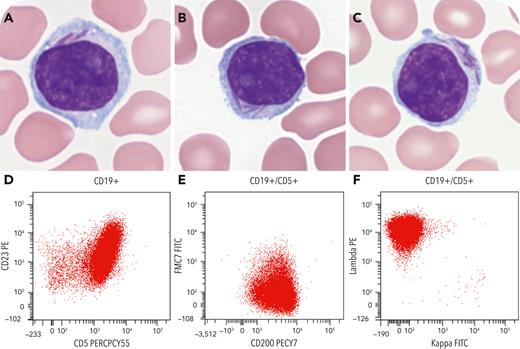A 64-year-old man presented with leukocytosis with absolute abnormal lymphocytosis. The lymphocytes were small to medium in size with mature chromatin and variably prominent nucleoli (with 20% prolymphocytes noted), with a few demonstrating needle-shaped azurophilic cytoplasmic inclusions resembling Auer rods (panels A-C, 100× objective; Wright-Giemsa stained peripheral blood smear). Flow cytometry analysis revealed a mature CD5+ surface λ light chain–restricted B-cell population expressing CD23 and CD200 and negative for FMC7 (panels D-F). Cytogenetic karyotype revealed an abnormal male karyotype: 46,XY,del(7)(q22q32),del(13)(q12q14)add(13)(q34),del(14)(q11.2q24)[20]. The patient was diagnosed with chronic lymphocytic leukemia.
Auer rods are a morphologic hallmark of myeloid differentiation in neoplastic blasts. However, Auer rod–like inclusions do not always indicate a high-grade myeloid neoplasm and can rarely be found in B-cell lymphoproliferative disorders. The composition of these inclusions is uncertain with some proposing a lysosomal origin and others hypothesizing they are abnormal immunoglobulin precipitates. Considering the difference in therapy and prognosis for myeloid versus lymphoid malignancies, it is important to make the distinction, and additional studies are essential to arrive at a correct diagnosis. In general, cases with Auer rod–like inclusions can be diagnostically challenging and require the correlation of morphology, cytochemistry, immunophenotype, and sometimes cytogenetic or molecular studies to confirm the lineage of the neoplastic cells and establish the correct pathologic diagnosis.
For additional images, visit the ASH Image Bank, a reference and teaching tool that is continually updated with new atlas and case study images. For more information, visit https://imagebank.hematology.org.


This feature is available to Subscribers Only
Sign In or Create an Account Close Modal